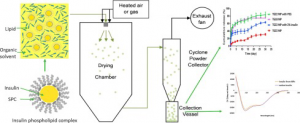Effect of excipients on encapsulation and release of insulin from spray-dried solid lipid microparticles
13. September 2018
The study aimed at investigating the potential of spray drying method for encapsulation of protein drugs into solid lipid microparticles (MP) and evaluating effects of excipients on encapsulation and release of protein from MP. After transformation of model protein insulin to insulin-phospholipid complex, it was dissolved together with lipid excipients in organic solvent, which was spray-dried to form solid lipid MP. Polymeric MP with D, L-lactic-co-glycolic acid (PLGA) were prepared similarly. Around 90% of insulin was encapsulated in glycerol monostearate

MP and glycerol distearate MP, whereas the encapsulation efficiency was 60% and 35% for tristearate (TG18) MP and tribehenate (TG22) MP, respectively. The secondary structure of insulin in the spray-dried MP was substantially similar to that of the insulin control solution, suggesting that only minor alterations occurred during the spray drying process. Sustained release of insulin was observed from both TG18 MP and TG22 MP. The burst release of insulin from TG18 MP and TG22 MP was around 30% and 10%, respectively, which was significantly lower than that from PLGA MP(40%). In conclusion, spray drying a solution containing both lipids and protein-phospholipid complex is a promising method for encapsulating protein into solid lipid MP, which can be used for sustained delivery of protein drugs.

